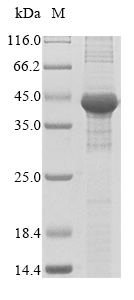The production of this recombinant Human FASN protein is just like all recombinant proteins. The process involved transfecting E.coli cells with DNA vector containing the template of recombinant DNA. The E.coli cells containing the template were then cultured so that they could transcribe and translate the FASN protein. N-terminal 6xHis tag was used in the process. The purity is 85% determined by SDS-PAGE.
FASN is a gene providing instructions for making a protein called fatty acid synthase (also known as type I fatty acid synthase) in human. This protein is a multifunctional protein involved acetyl-CoA metabolic process, cellular response to interleukin-4, establishment of endothelial intestinal barrier, and monocyte differentiation. Its main function is to catalyze the synthesis of palmitate from acetyl-CoA and malonyl-CoA, in the presence of NADPH, into long-chain saturated fatty acids. This protein contains 7 catalytic activities and a site for the binding of the prosthetic group 4'-phosphopantetheine of the acyl carrier protein ([ACP]) domain.






